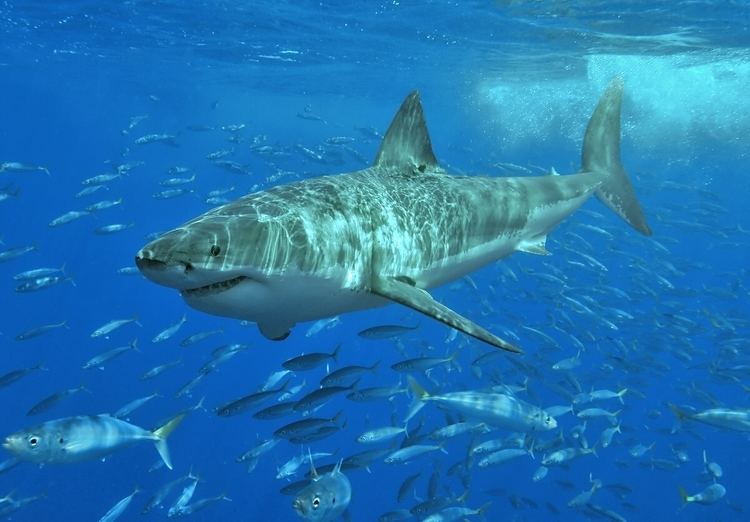The following outline is provided as an overview of and topical guide to sharks:
Sharks (superorder Selachimorpha) – a type of fish with a full cartilaginous skeleton and a highly streamlined body. The earliest known sharks date from more than 440 million years ago, before the time of the dinosaurs.
Ichthyology – branch of zoology devoted to fish (including sharks)Meristics – branch of ichthyology that relates to counting features of fish, such as the number of fins or scalesA shark, also called a "selachimorph", can be described as all of the following:
Animal – multicellular, eukaryotic organism of the kingdom Animalia or Metazoa. An animal's body plan eventually becomes fixed as it develops, although some types of animal undergo a process of metamorphosis later on in their life. Most kinds of animal are motile, meaning they can move spontaneously and independently.Chordate – Chordates (phylum Chordata) are animals which are either vertebrates or one of several closely related invertebrates.Fish – gill-bearing aquatic vertebrate (or craniate) animal that lacks limbs with digits.Chondrichthye (cartilaginous fish) – jawed fish with paired fins, paired nares, scales, two-chambered hearts, and skeletons made of cartilage rather than bone.Elasmobranch – member of the subclass Elasmobranchii, which includes sharks, rays, and skates.Predator – organism that attacks and feeds on prey (the organism that is attacked).Apex predator – some shark species are apex predators, that is, predators with no predators of their own, residing at the top of their food chain.Kingdom: AnimaliaPhylum: ChordataClass: ChondrichthyesSubclass: ElasmobranchiiSuperorder: SelachimorphaSubdivisions of the biological classification Selachimorpha include:
Carcharhiniformes – ground sharksHeterodontiformes – bullhead sharksHexanchiformes – the five extant species of the most primitive types of sharksLamniformes – mackerel sharksOrectolobiformes – includes carpet sharks, including zebra sharks, nurse sharks, wobbegongs, and the whale sharkPristiophoriformes – includes sawsharksSqualiformes – includes gulper sharks, bramble sharks, lantern sharks, rough sharks, sleeper sharks and dogfish sharksSquatiniformes – angel sharks† Cladoselachiformes† Hybodontiformes† Symmoriida† Xenacanthida (Xenacantiformes)PredationApex predatorShark threat display – Behaviour shown by some sharks when threatenedSpy hopping – Raising the head out of the waterInternational Shark Attack FileList of fatal, unprovoked shark attacks in the United StatesJersey Shore shark attacks of 1916 – series of shark attacks along the coast of New Jersey between July 1 and July 12, 1916Summer of the Shark – the name given to the summer of 2001 by American media outlets capitalizing on a bull shark attack and subsequent shark attacks Bodies of water in which sharks can be found include:Seas: allFreshwater – some species of shark can live both in seawater and freshwater, and include:Bull sharkRiver sharkSandbar sharkDepths: from the surface down to depths of 2,000 metres (6,600 ft).White Shark Cafe – remote mid-Pacific Ocean area noted as a winter and spring habitat of otherwise coastal great white sharksShark tankShark tunnel – underwater tunnel that passes through an aquarium that keeps sharksPhysical characteristics of sharks – shark skeleton, respiration and skinDermal denticle – small outgrowths which cover the skin of sharksAmpullae of Lorenzini – sensing organ that helps sharks and fish to sense electric fieldsElectroreception – the biological ability to perceive electrical impulses (see also Ampullae of Lorenzini)Lateral line – sense organ that detects movement and vibration in the surrounding waterShark cartilage – material that a sharks' skeleton is composed ofShark teethSpiracle – pumps water across gillsClasper – the anatomical structure that male sharks use for matingFish anatomy – generic description of fish anatomyDrum linesShark net – submerged net placed around beaches to reduce shark attacks on swimmersShark proof cage – cage from which a SCUBA diver can examine sharks more safelyShark repellent – method of driving sharks from an area, object, person, or animalMagnetic shark repellent – use of permanent magnet to repel sharksProtective Oceanic Device – first successful electronic shark repellentShark suitDrivers of the shark tradeLand-based shark fishing – fishing for sharks from land such as a beach, shoreline, jetty, pier, or bridgeShark finning–the removal of shark fins for commercial purposes1992 Cageless shark-diving expedition – 1st publicized cageless dive with great white sharks which contributed to changing public opinions about the supposed "killing machine"Shark Alliance – coalition of non-governmental organizations dedicated to restoring and conserving shark populations by improving European fishing policyShark Conservation Act – Proposed US law to protect sharksShark sanctuary – Palau's first-ever attempt to prohibit taking sharks within its territorial watersShark tourism – form of ecotourism showcasing sharksShark Trust – A UK organisation for conservation of sharksStronsay Beast – large, dead creature washed ashore on Stronsay, in the Orkney Islands, after a storm in 1808, later presumed to be a basking sharkNotable researchers and people
Peter Benchley – author of the novel Jaws, later worked for shark conservationJacques-Yves Cousteau – French naval officer, explorer, ecologist, filmmaker, innovator, scientist, photographer, author and researcher who studied the sea and all forms of life in water including sharksEugenie Clark – American ichthyologist researching poisonous fish and the behavior of sharks; popularly known as The Shark LadyLeonard Compagno – international authority on shark taxonomy, best known for 1984 catalog of shark species (FAO)Ben Cropp – Australian former shark hunter, who stopped in 1962 to produce some 150 wildlife documentariesRichard Ellis – American marine biologist, author, and illustrator.Rodney Fox – Australian film maker, conservationist, survivor of great white shark attack and one of the world's foremost authorities on themAndre Hartman – South African diving guide best known for free-diving unprotected with great white sharksHans Hass – diving pioneer, known for shark documentariesMike Rutzen – great white shark expert and outspoken champion of shark conservation; known for free diving unprotected with great white sharksRon & Valerie Taylor – ex-spearfishing champions who switched from killing to filming underwater documentaries 
